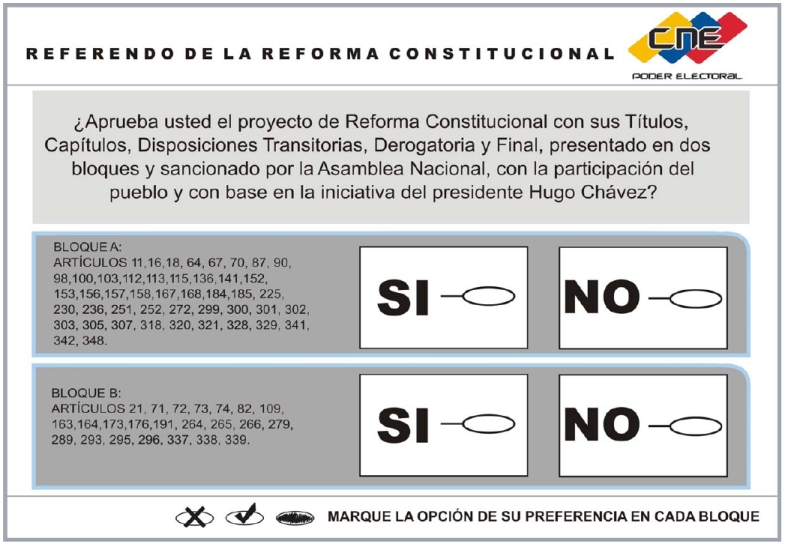I have long wondered as to the exact structure of the ballot for the pending constitutional reform referendum that will take place this Sunday. The coverage has long suggested that the citizens would have to give an up or down vote on the whole package, but I never saw that fact categorically stated. Since news coverage of electoral procedures is typically quite poor, I didn’t want to take anything for granted. The structure of the questions is not an insignificant matter, as if the voters could say “yes” or “no” on each individual amendment, they could selectively take the goodies and reject some (or all) of the power-enhancements sought by Chávez.
Of course, under such a scenario there would still be an issue of information overload to be considered, especially given the complex nature of constitutional reform in general, let alone when it affects this many articles. Still, a proposal-by-proposal breakdown would be far better than an up or down vote on the whole package, as such a choice would force voters to weigh how much they wanted, say, the social reforms versus how much they might not want to agree to the various power enhancements present.
As it turns out, the voters will be asked two questions, or more specifically, they will be allowed to accept or reject two blocks of amendments, as per the following sample ballot:

Source: CNE
A specific explanation of the two blocks can be found at venezuelanalysis.com which notes:
Venezuelans will vote on the reform on December 2nd and will do so in two blocks. Block “A” includes President Chavez’s original proposal, as amended by the National Assembly, which would change 33 articles out of the 350 articles in the constitution. Also included in block A are another 13 articles introduced by the National Assembly. Block “B” includes another 26 reform articles proposed by the National Assembly. Voters may vote “Yes” or “No” on each block.
The site also has an English-language summary of the proposed amendments. Both the original amendments proposed by the President, as well as those added by the National Assembly, have a mixture of enhancements of the government’s power along with social reforms. As such, voters are not given clear choices, but muddled ones.
If one wishes to see the entire set of reforms in Spanish, they can be found here [PDF].


November 29th, 2026 at 4:15 pm
Great stuff, Prof. Poliblogger!
So, two packages, lots bundled into each.
November 29th, 2026 at 4:49 pm
Nothing like a good old-fashioned logroll!
November 29th, 2026 at 5:06 pm
More like a whole forest!
November 29th, 2026 at 6:38 pm
Grim. Such a referendum would be clearly unacceptable in Portugal. Referndum questions have to be very specific and clear. Nothing like this sort of listing would be permissable here – our Constitution would not allow for it. Doesn’t feel at all right…
Regards.
November 30th, 2026 at 8:14 pm
The electoral path to authoritarianism?
A president need not have an institutionalized party as his vehicle for political support. It is feasible to have a party that is little more than a vehicle for placing presidential loyalists in the legislature via the president’s own coattails. …